2/5/25 – Boundary Waters permits have officially been available for a full week which has us reflecting on past canoe trips and ones yet to come. -Jessica
Category: Blog
FS Press Release to Review Before Permits Go Live
1/20/25 – The Forest Service recently published the following press release outlining some important information to know before booking your permit. Included are answers to some frequently (and not so frequently) asked questions as well as some helpful tips for a smoother experience on recreation.gov.
After reviewing the press release you might also be interested in watching our BWCA permit reservation how-to video, and as always feel free to call or email with any questions!
Also of note; we have availability for all canoe types for all dates at this point, so you can book your permit with confidence that we will have a canoe for you! -Jessica
Facts & Tips for Reserving a Permit and Planning a Trip to the Boundary Waters Canoe Area Wilderness
Release Date: Jan 17, 2025
Contact(s): Joy VanDrie, Public Affairs Staff Officer, Cathy Quinn, Assistant Wilderness Program Manager
The Boundary Waters Canoe Area Wilderness (BWCAW) permit reservations for the 2025 quota season, May 1 – September 30, go on sale beginning at 9:00 a.m. CST on Wednesday, January 29, 2025, through Tuesday, September 30, 2025. Visitors taking an overnight paddle, overnight motor, overnight hiking trip, or a motorized day trip into the BWCAW between May and September are required to obtain a quota permit. Visitors are encouraged to book their reservations online at www.recreation.gov or by calling 1-877-444-6777.
Data suggests visitors reserve more permits than they can use. Forest managers ask everyone to keep these facts in mind while planning a BWCAW adventure:
- Reservations surged during the pandemic, while cancellations more than doubled in six years.
- In 2024, over 11,000 permits were cancelled, 58 percent were reserved in January.
- Cancelled reservations are available for resale within 24 hours so there’s no shortage of quota.
- “No-shows” without cancellation has increased in the BWCAW.
You can help prevent stockpiling and hoarding permits by following these best practices:
One Permit per Day
- The Forest Service reserves the right to cancel multiple same day, overlapping, and consecutive reservations under the same permit holder name without notification. Permit holders are limited to one permit per day, because they can physically only be in one place at a time and must stay with their group for the duration of the trip.
Cancel Right Away
Cancel immediately if you cannot go using the Recreation.gov app. The app is not recommended for on-sale events, for best results on January 29, use a computer or laptop with Chrome.
Tips for making a successful reservation:
- Plan Ahead: Have at least three travel options (dates and entry points) in mind if your preferred option is unavailable yet only reserve the permit you can use.
- Be Considerate of Others: Know where and when you are going before making a reservation. When visitors only reserve the permit they can use, entry points have more quota available, and groups have more time to plan trips that fit their skill level.
- Permits are not transferable: Permit holder, alternates, entry date and entry point cannot be changed once the permit reservation is made. Only the permit holder or alternate permit holders specified at the time of reservation can pick up the permit (photo I.D. required). Permits must be picked up on the entry date or one day prior.
- Alternate Permit Holders: Check the box under group member names to select alternates who can pick up the permit if the permit holder cannot go. Alternates cannot be added later.
- On-line Reservations: The latest version of Chrome is recommended. Create a Recreation.gov account or ensure you have one. Be logged in and refresh your screen at 9:00 a.m. CST to begin.
- Issue Stations: Change issue stations online at Recreation.gov. Log in and select “Reservations” to modify a permit. Review hours and locations to select an issue station near your entry point.
- Multi-factor Authentication (MFA): MFA is new and completely optional for visitors to access their Recreation.gov account. This selection adds a layer of security but is not required.
- Fees & Cancellations: Review this section of the BWCAW permit to ensure you are aware of all related fees and the cancellation policy – www.recreation.gov/permits/233396.
Successful trips are the result of careful planning!
- Leave No Trace Videos: Watch and share the Leave No Trace (LNT) video series with your group prior to arrival. Then watch Part 3 and review the BWCAW Regulations and Rules at issuance
- BWCAW Trip Planning Guide: Review the trip planner. Topics include permits, Leave No Trace, regulations and rules, safety, entry points, maps, history, volunteering, and more!
- Trip Itinerary: The BWCA Wilderness is over 1 million acres in size. Leave a trip itinerary with family or friends prior to departure, see example on page 23 of the trip planner.
- Route Planning: Look online for route planning guidebooks, trip ideas and information. Contact local outfitters, guides, resorts, or commercial issue stations.
- Bear Awareness: BWCAW visitors are required to properly store food. Read the Forest Order and consider using IGBC approved containers, product-tested and found to be resistant to bears.
- Superior NF Recreation Opportunities: Is wilderness the best option for your group? The forest has 3 million acres with over 200 backcountry campsites that require no fees or reservations. Visit the Superior National Forest website for canoe routes (outside BWCAW).
The Big Day Approaches
1/8/25 – Permits open for the upcoming paddling season Wednesday, January 29th at 9am CT (via www.recreation.gov). Now that we’re less than a month away it’s the perfect time to unfold your free map and route guide and start dreaming about where you might like to go on your trip.
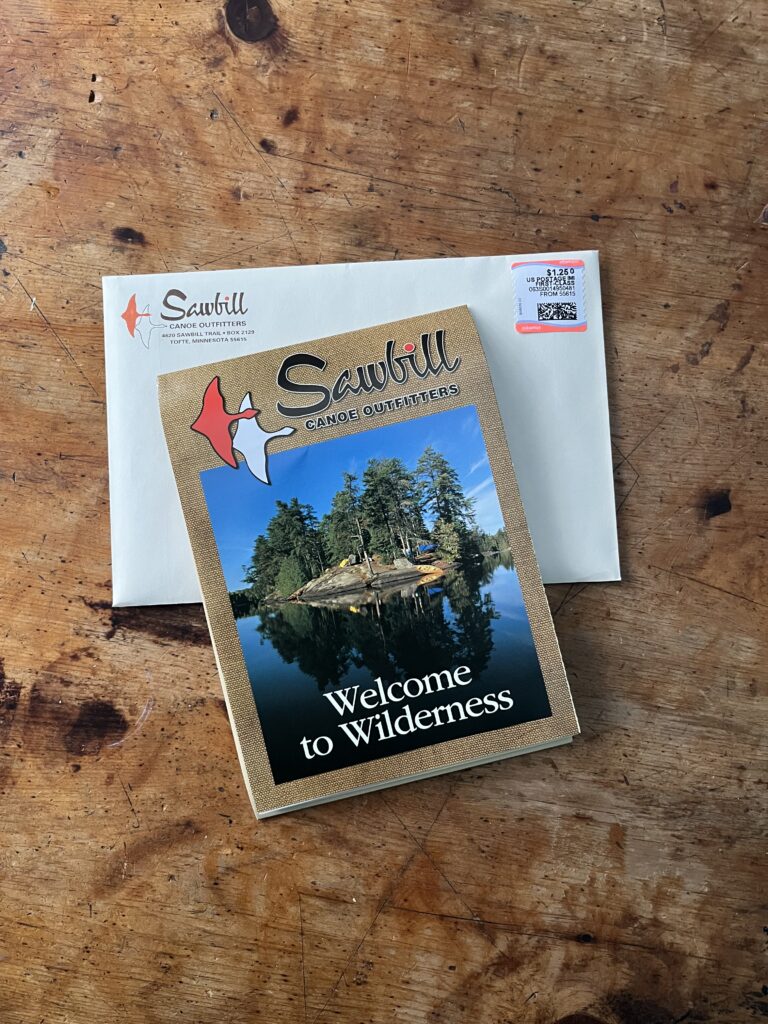
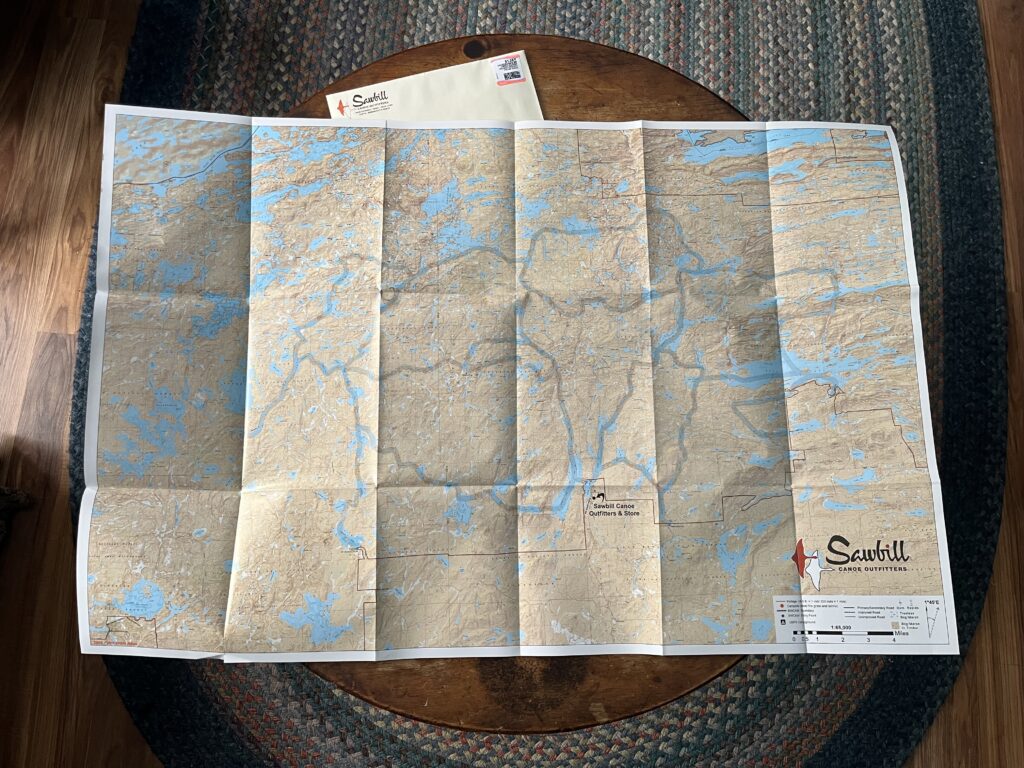
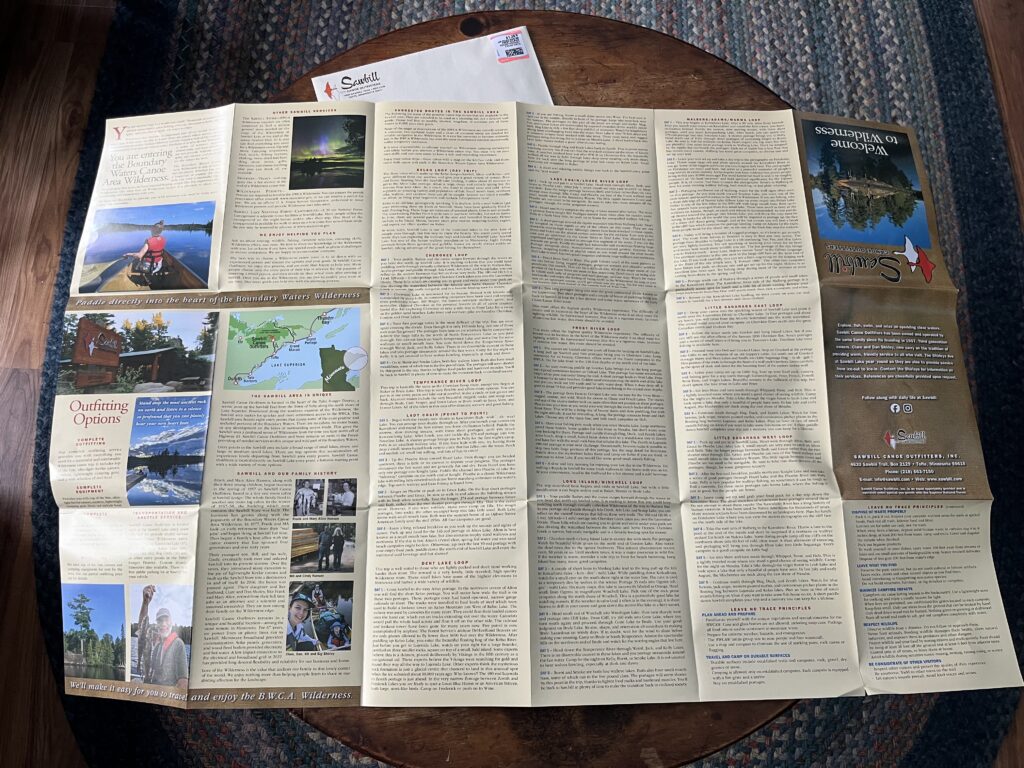
To get your hands on one of these puppies submit our online request form, or give us a call at 218-663-7150. We’re around all winter and happy to answer questions! -Jessica
Happy New Year!
1/1/25 – The final days of 2024 we ate, drank, and were merry. We also took multiple walks/shuffles (it’s slippery out there!) on Sawbill Lake with auger in tow. We found varying qualities and thicknesses of ice, but most often there was 9-10 inches of ice, with 5+ inches of it being clear. Occasionally we would auger into a water pocket between the cloudy frozen slush and clear ice.
Also on the docket was a brief jaunt over to Alton where a test hole revealed 9 inches of mostly clear ice. It was a little breezy so we only drilled one hole straight out from the portage and then quickly went back the way we came. My guess is that Alton froze over after Sawbill, so it potentially was less affected by the windy, snowy, slushy, mess that reeked havoc on Sawbill’s ice. Hard to say for sure though. -Jessica
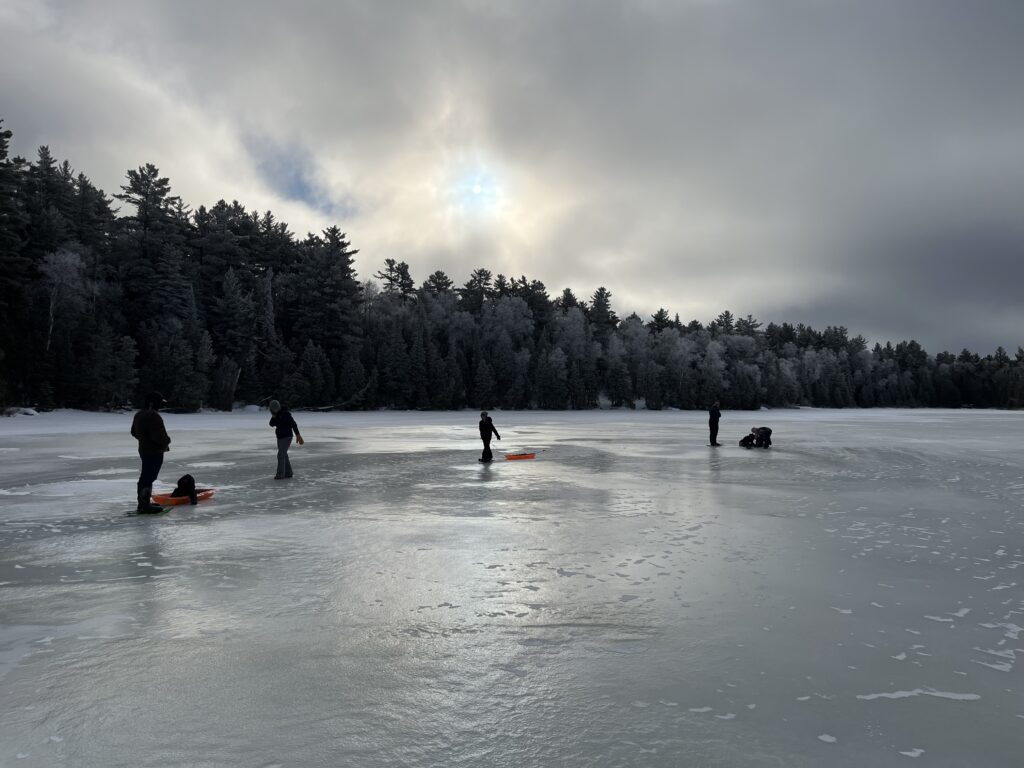
Another Ice Check
12/22/24 – One more inch of ice has been added since the last measurement, but otherwise things seem about the same out there. The total in front of the landing now clocks in at 5″ clear ice, with another 5″ of compact frozen slush on top of that.
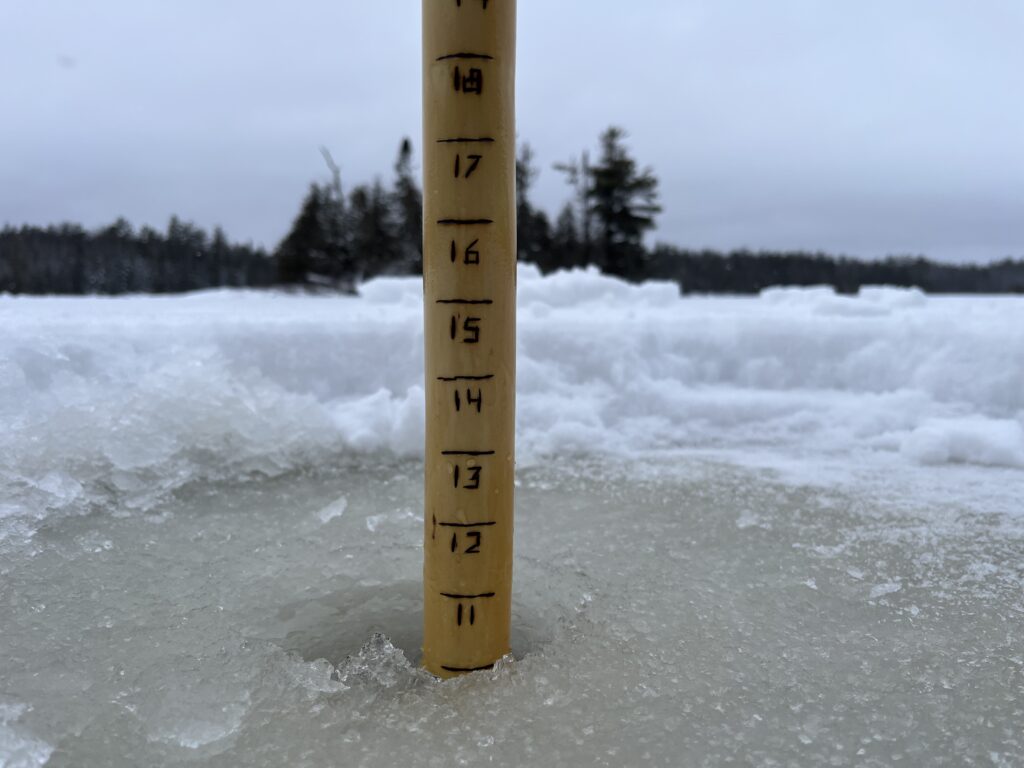
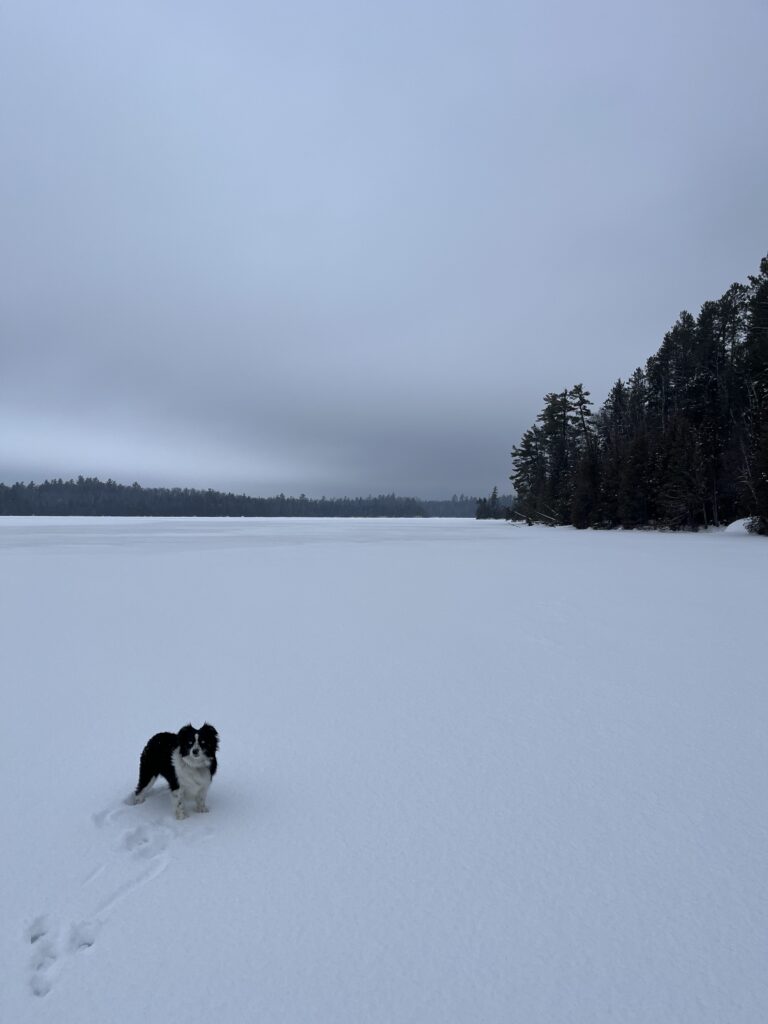
After drilling a couple test holes Chile and I went for a short walk up the eastern shore. The thermometer read 18°F before we headed out for the walk, but it sure didn’t feel that warm. Just enough of a breeze and some sort of mist in the air prompted an about face by the time we reached the half way point of the campground. -Jessica
Boundary Waters History With Bill Hansen
12/19/24 – Earlier this winter we received the following customer inquiry and it had some of us a bit stumped…
Found your interesting trip planning info online when I was searching for evidence of old CCC camps. About 40 years ago my husband and I were on a trip from Malberg Lake going east and happened upon an old camp with huge picnic tables. I believe it was right before Dent Lake. Obviously built by the CCC in the 30s. Do you happen to know what I’m talking about? I’d love to figure out which lake that was. Didn’t write it down!

Luckily, our very own Bill Hansen had some insight.
Thanks for your question.
During the CCC era, visionaries like Aldo Leopold and Bob Marshall in the U.S. Forest Service were pushing for wilderness designation of wild areas all across the country, recognizing that a constituency of wilderness recreation enthusiasts would help their cause. A huge amount of CCC effort was dedicated to the BWCA Wilderness, known then as the “Roadless Area.” Ancient canoe routes were mapped and improved with extensive “improvements” to portages and campsites, including portage grading, bridges and canoe rests. As a part of the effort, beautiful and massive log tables were built on campsites, along with log docks at the ends of portages. Signs were installed, not only on portage landings, but along lakeshores to guide travelers along established routes.
The log tables rotted out fairly quickly, so in the 1960s the Forest Service started replacing them with stained tables made from dimension lumber. They concentrated their efforts on the most popular lakes and larger lakes that allowed them to fly in the disassembled tables with their Beaver aircraft. The more remote routes, like the Louse River where you traveled, retained their log tables and docks into the late 1970s and even the early 1980s in some obscure locations. One of the last log tables that I’m aware of (probably the one you saw) was on Zenith Lake which is on the Louse River route east of Dent Lake. It may also have been Frederick Lake or even Mesaba, depending on how long ago you were there.
The treadwork that the CCC did is still plainly visible on many portages–if you really look for it–a testament to an era when people were remarkably skilled with stone and wood. Remnants of the docks are still visible too, especially along the Louse River route, with rusting spikes in preserved logs under water. After the 1964 Wilderness Act made the BWCAW a formal part of the wilderness system, the Forest Service gradually abandoned all the CCC amenities for users’ convenience and emphasized work that protects the resource itself–things like the fire grates, privies and erosion control. The signs, canoe rests and picnic tables are all just memories now. Although some old-timers grumble, I believe this policy is much more in line with the intent of the Wilderness Act, which eloquently says, “A wilderness, in contrast with those areas where man and his works dominate the landscape, is hereby recognized as an area where the earth and its community of life are untrammeled by man, where man himself is a visitor who does not remain.”
I hope this was helpful.
Sincerely,
Bill Hansen
Former owner of Sawbill Canoe Outfitters
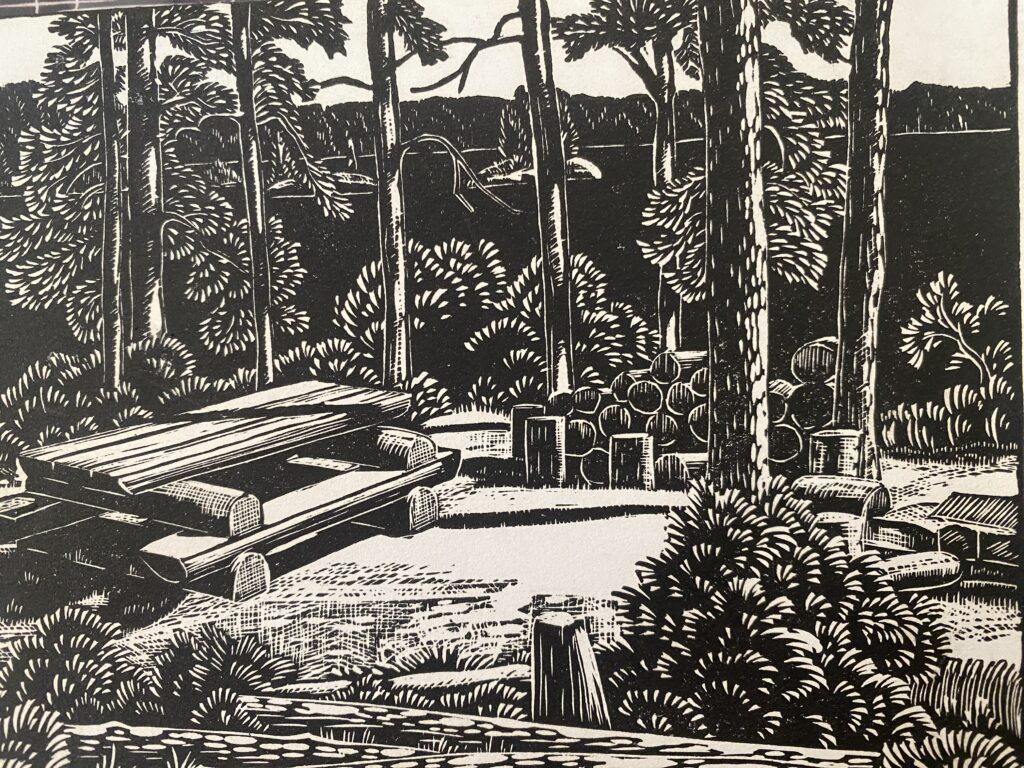
Ice Check
12/13/24 – We’ve been receiving a few emails recently asking how thick the ice is on Sawbill Lake. Up until now the conditions have either been too cold, too windy, or I’ve been too chicken to venture out onto the early season ice. This afternoon I finally worked up the gumption to go see what’s what.
After gathering the necessary tools I gingerly made my way out onto the lake, probably only 20 paces or so. With what felt like a few rotations of the auger the hole was quickly drilled. Upon consulting the official ice measuring stick I found no more than 4″ of ice with about 5-1/2″ of somewhat compact slush on top of it. For reference the DNR recommends a minimum of 4″ of new clear ice for travel on foot, but I couldn’t tell how clear this ice was since it was under a bunch of slush. Personally I prefer more like 6″ or more of solid ice so after taking proper documentation I retraced my steps back to shore. -Jessica
Sights and Sounds of December
12/10/24 – This past weekend winter arrived in earnest. The festivities started off with a round of snow, followed by freezing rain, then more snow. All of that resulting in just over a foot of the white stuff now blanketing the woods.
Today fluffy flakes continue to fall, but at a much slower rate than the past few days. To highlight the vibe of the day I’ve included a few videos I took this early afternoon. -Jessica
Bill’s Retirement Gig
12/4/24 – Ever wonder what Sawbill’s own Bill Hansen is up to following retirement from the outfitting business? WTIP North Shore Community Radio recently released this short film highlighting just that. -Jessica
Welcome Snow!
11/25/24 – Today marks the first snow accumulation of the season along with some notable skim ice and slush along the shore.
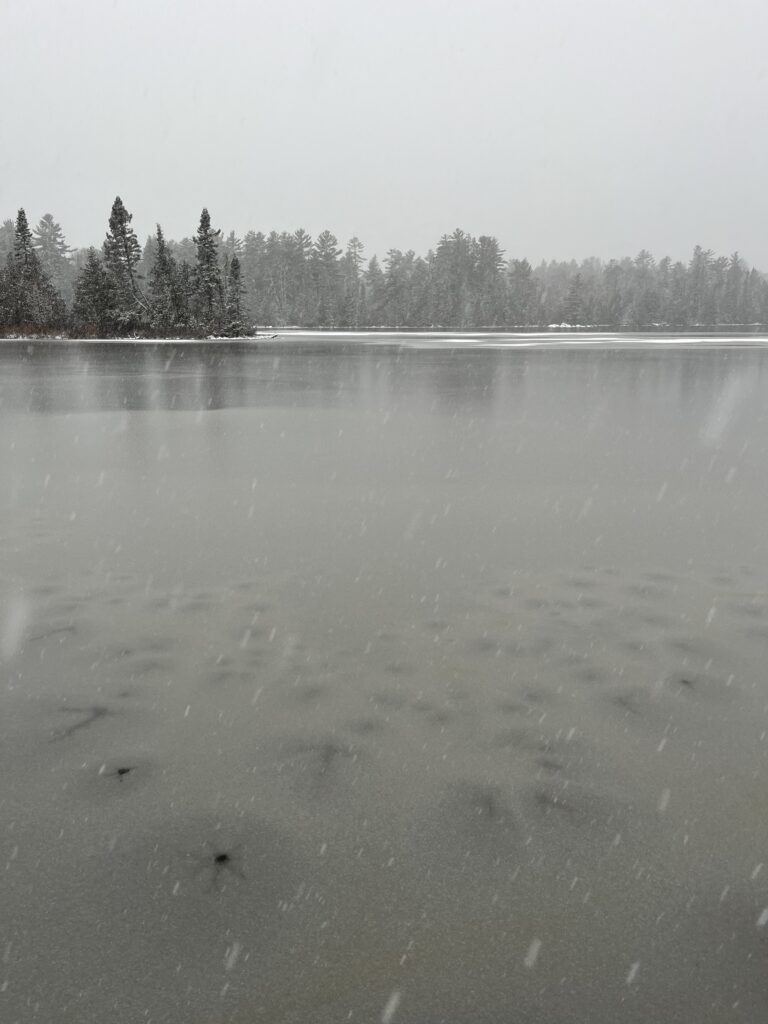

The past few days the skim ice has all but disappeared by midday. Today, however, that has not been the case and this weeks forecast is predicting highs in the 20s and lows in the teens. It seems as though permanent freeze up is near… We shall see. -Jessica
